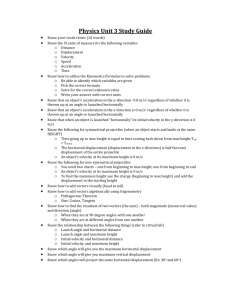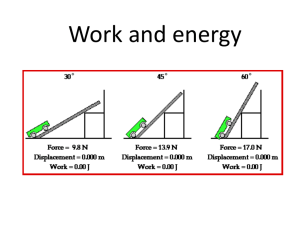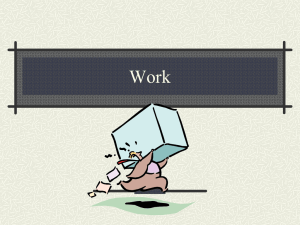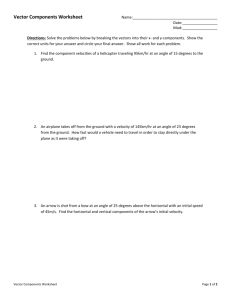Work - HRSBSTAFF Home Page
advertisement
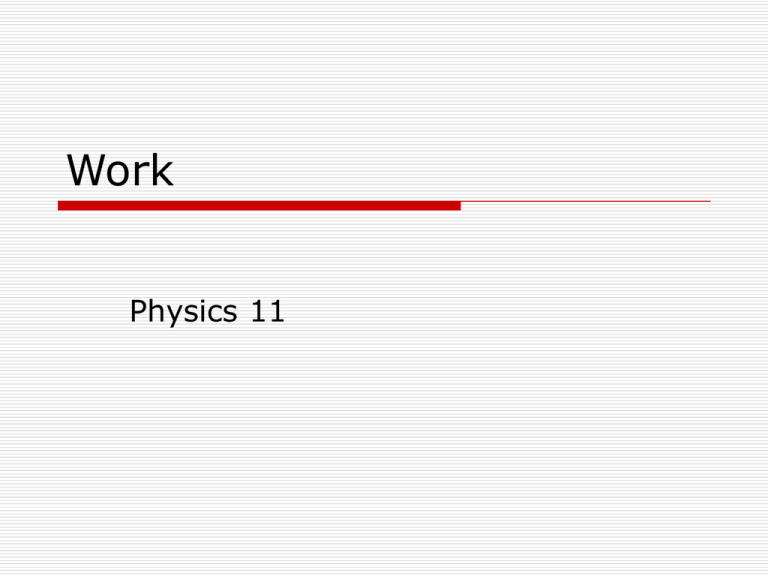
Work Physics 11 Comprehension Check 1. What is the impulse given to a golf ball of mass 45.9g if it starts at rest and attains a final velocity of 35m/s? 2. If the golf ball in problem 1 was in contact with the golf club for 0.027s, what force acted on the golf ball? 3. What is the change in momentum of a car as it accelerates from 15m/s to 25m/s if the car as a mass 950kg? Comprehension Check 1. 1.6Ns 2. 6.0x101N 3. 9500kgm/s Page 203, questions 33 to 35 Page 209, questions 37 to 46 Work In common language, work can mean a variety of different things, however when we describe work from a scientific standpoint, work has a very precise definition This means we must be careful not to confuse work as used in the English language and the work we will determine in physics Work – The physics definition Work is the transfer of mechanical energy (total kinetic and potential energy). Work is done only if an object moves. When the work is done upon the object, that object gains energy Work is only done on an object when the force and displacement are in the same direction. Work The symbol is W Units: Joule (J) 1 J = 1 Nm Work is a scalar*** W F d W Fd cos Zero Work Conditions How can we make work equal zero? 1) Apply a force that does not cause motion Example: Holding an object at the same height for hours is not doing any work you may get tired but you are doing no work on the object. Zero Work Conditions 2) Uniform motion in the absence of a force Example: If an object is already in motion, it will continue in that same motion (Newton’s First Law). If a hockey puck is sliding across the ice at a constant speed, no work is being done. Zero Work Conditions 3) Applying a force that is perpendicular to the motion Example: You are carrying a book down the hallway. You are lifting the book (force is upwards) but your motion is forwards (perpendicular). Therefore there is no work being done on the textbook by the person once you are moving. What about this situation… work or no work? If you swing a mass on a string, is there work being done? Why or why not? If you are pushing a grocery cart through the store. If you are pushing a car and it is going forward? Backward? Not moving? Example 1: (page 220) A student is rearranging her room. She decides to move her desk across the room a distance of 3.00m. She moves the desk at a constant velocity by exerting a horizontal force of 200N. Calculate the amount of work done on the desk by the student. W = Fd W = 200 x 3 W = 600 J Comprehension Check 1. How much work is done if you push on a wall with 3500N but the wall does not move? 2. How much work is done by you on the book if you are carrying the book down the hall at constant velocity? 3. How much work is done by you if you push a box that has a mass of 50kg down the hallway 45m with a force of 25N? Comprehension Check 1. 0 2. 0 Practice Problems Page 221, questions 1, 2, 3 Remember, work is done if a force is exerted in the direction of motion. If you are pushing or pulling something at an angle, only the component that acts in the direction of motion is doing work. W = F d cos Θ Example 2: An applied force of 20. N accelerates a block across a level, frictionless surface from rest to a velocity of 8.0 m/s in a time of 2.5 s. Calculate the work done by this force. Practice Problems Page 225 4-10 Example 3: A person is doing work on the lawn mower by pushing with 105N it at an angle of 40° to the horizontal. If the person pushes the mower for 5.00m, how much work is being done on the mower? WHAT EQUATION DO WE USE? WHY? W = F d cos Θ We use this equation because the handle on the lawn mower is at an angle so we only need the Fx value (cos). W = (105)(5)cos40 = Practice Problems 1. If you pull a crate with a force of 550N at an angle of 35° to the horizontal and it moves 25m horizontally, how much work was done? (1.1x104J) Page 235, questions 16, 17 Using Graphs to Calculate Work Estimating Work from a Graph Positive and Negative Work When we consider work it is a scalar so lacks direction How is it possible to have positive and negative work? Positive and Negative Work Positive work occurs when the angle between the force and displacement is 0°90° “Negative work” occurs when the angle between the force and displacement is 90°-180° F d F d The Meaning of Negative Work On occasion, a force acts upon a moving object to hinder a displacement. Examples might include a car skidding to a stop on a roadway surface or a baseball runner sliding to a stop on the infield dirt. In such instances, the force acts in the direction opposite the objects motion in order to slow it down. The force doesn't cause the displacement but rather hinders it. Example: Imagine a weight lifter. She must lift the bar-bell up and then lower it down. Overall, she has done NO WORK but she has done positive work when she lifts the bar-bell and negative work (the same amount) to lower it. Practice Problems Page 229 Questions 11 (a, b, c only), 12, 13 in Practice Page 235 14, 15, 18 Page 235 Section Review q 3, 4, 5
